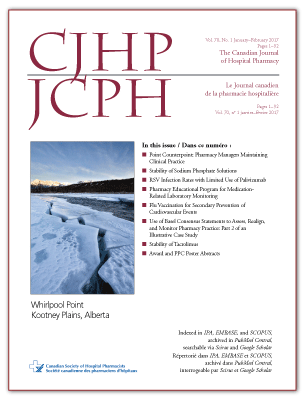Extended Stability of Sodium Phosphate Solutions in Polyvinyl Chloride Bags
DOI:
https://doi.org/10.4212/cjhp.v70i1.1622Keywords:
sodium phosphate, drug stability, IV therapy, phosphate de sodium, stabilité des médicaments, traitement par voie intraveineuseAbstract
ABSTRACT
Background: Sodium phosphate injection is used to treat moderate to severe hypophosphatemia. There have been no published reports documenting the physical compatibility or chemical stability of sodium phosphate injection in IV solutions.
Objective: To evaluate the physical compatibility and chemical stability of 30 and 150 mmol/L solutions of phosphate, prepared from sodium phosphate injection, in 5% dextrose in water (D5W) and in 0.9% sodium chloride (normal saline [NS]) and stored in polyvinyl chloride (PVC) bags at 23°C or 4°C over 63 days.
Methods: On study day 0, solutions of phosphate 30 and 150 mmol/L in D5W or NS were prepared in PVC bags and stored at 4°C and 23°C. On prespecified days during the 63-day study period, the concentrations of sodium and phosphate were determined, and admixture weight was checked to assess moisture loss during storage without a plastic overwrap. Chemical stability was calculated from the intersection of the lower 95% confidence limit of the degradation rate and the lower limit of acceptability (90%) for concentration remaining.
Results: The analytical methods for both sodium and phosphate were found to be precise (coefficient of variation averaging less than 1% for pre-study validation samples). Both sodium and phosphate retained more than 94% of the initial concentration over the 63-day study period. With 95% confidence, the time to achieve 90% of the initial concentration of both sodium and phosphate approached or exceeded the 63-day study period, regardless of temperature, concentration, or base solution.
Conclusions: Sodium phosphate solutions at a phosphate concentration of 30 or 150 mmol/L in either NS or D5W retained more than 94% of the initial concentration of both sodium and phosphate over 63 days when stored at 23°C or 4°C. In compliance with United States Pharmacopeia General Chapter <797> recommendations, a beyond-use date of 14 days (with refrigeration) or 48 h (room temperature) may be applied. Extending the beyond-use date beyond these limits may be considered, if a validated sterility test is performed.
RÉSUMÉ
Contexte : Le phosphate de sodium injectable est employé pour traiter l’hypophosphatémie modérée et grave. À ce jour, aucun rapport portant sur la compatibilité physique ou la stabilité chimique du phosphate de sodium injectable contenu dans les solutions intraveineuses n’a été publié.
Objectif : Évaluer la compatibilité physique et la stabilité chimique de solutions de phosphate à des concentrations de 30 et de 150 mmol/L préparées à partir de phosphate de sodium injectable dilué dans du dextrose à 5 % dans l’eau (D5E) ou du chlorure de sodium à 0,9 % (solution physiologique salée [SP]) puis rangées dans des sacs de polychlorure de vinyle (PVC) à des températures de 4 °C ou de 23 °C pendant 63 jours.
Méthodes : Au jour 0 de l’étude, les solutions de phosphate à des concentrations de 30 et de 150 mmol/L ont été préparées avec du D5E ou de la SP dans des sacs de PVC, puis entreposées à des températures de 4 °C ou de 23 °C. À des jours donnés pendant la période de 63 jours de l’étude, on a évalué les concentrations de sodium et de phosphate et l’on a pesé les mélanges pour vérifier la perte d’humidité pendant un entreposage n’utilisant pas de suremballage de plastique. La stabilité chimique était calculée au point d’intersection entre la limite inférieure de confiance à 95 % du taux de dégradation et la limite inférieure d’acceptabilité (90 %) de la concentration restante.
Résultats : Les méthodes analytiques employées pour évaluer le sodium et le phosphate se sont révélées précises (coefficient de variation moyen inférieur à 1 % pour les échantillons aux fins de validation avant l’étude). Le sodium et le phosphate conservaient chacun plus de 94 % de leurs concentrations initiales pendant la période d’étude de 63 jours. Avec un niveau de confiance de 95 %, le temps nécessaire pour atteindre 90 % de la concentration initiale pour le sodium et pour le phosphate approchait ou dépassait les 63 jours de la période d’étude, peu importe la température, la concentration ou la solution de base.
Conclusions : Les solutions de phosphate de sodium dont la concentration en phosphate est de 30 ou de 150 mmol/L, qu’elles soient à base de D5E ou de SP, conservaient plus de 94 % des concentrations initiales de sodium et de phosphate pendant 63 jours, qu’elles soient entreposées à des températures de 4 °C ou de 23 °C. Conformément aux recommandations contenues dans le chapitre <797> de la United States Pharmacopeia, une date limite d’utilisation de 14 jours (sous réfrigération) ou de 48 heures (à température ambiante) peut être utilisée. Allonger la date limite d’utilisation au-delà des bornes fixées par l’organisme américain peut être envisageable si une épreuve validée de stérilité est réalisée.
Downloads
Published
Issue
Section
License
Copyright © Canadian Society of Healthcare-Systems Pharmacy.
After publication of a manuscript in the CJHP, the authors of the manuscript must obtain written permission from the CSHP (publications@cshp.ca) before reproducing any text, figures, tables, or illustrations from the work in future works of their own. If a submitted manuscript is declined for publication in the CJHP, all said rights shall revert to the authors. Please note that any forms (e.g., preprinted orders and patient intake forms) used by a specific hospital or other health care facility and included as illustrative material with a manuscript are exempt from this copyright transfer. The CJHP will require a letter from the hospital or health care facility granting permission to publish the document(s).










